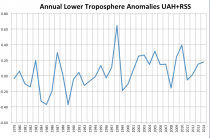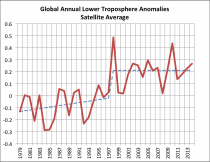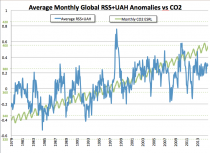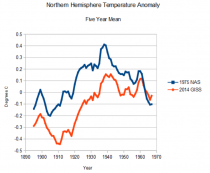By Anthony Sadar
Questioning global warming is no longer tolerated.
After hearing Environmental Protection Agency Administrator Gina McCarthy speak at this month’s annual meeting of the American Meteorological Society in Phoenix, Arizona, I realized that the United States is truly in a world of trouble from too much pollution - not the “carbon” kind, but the ideological kind.
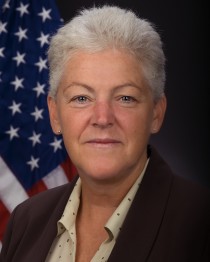
Ms. McCarthy’s presentation consisted of not only the typical derision of skeptics of man-made climate change and the distortion of climate reality, but included a rather delusional self-assessment.
Early in her talk, as usual, Ms. McCarthy denigrated any challengers to the so-called settled science of anthropogenic global warming as akin to “flat earth” believers. She went on to claim that our biggest danger is in not taking action to stop an evident climate catastrophe.
Ms. McCarthy declared that “science” is under attack as it has never been before and elaborated that there is an “all-out attack on science in D.C. right now.” Part of her solution is for scientists to be “more vocal,” supposedly to help her in the fight to save the planet.
For her part, Ms. McCarthy claimed that politics has “nothing zero” to do with her assessment of the science behind climate change. However, by all appearances, politics has everything to do with the issue. Much of her career has been closely tied to politics - apparently the kind aligned with statism - especially as an active state and federal bureaucrat.
Ms. McCarthy’s position of authority and her enthusiastic personal commitment and demeanor demands our attention, or perhaps, even our subservience. Make no mistake, the Obama administration is practically a driving force in climate science at the present time. The feds set the tone and those who are still honestly unconvinced of a looming disaster (aka “deniers") will not be tolerated. On the other hand, a fountain of federal funding is flowing for projects to evaluate weather and climate data with respect to how it proves that humans are altering the atmosphere. The compliant expectation of continued global warming is still the modus operandi in the atmospheric science field, even though, in spite of confident climate outlooks and a slight increase of global average temperature in 2014, readings have essentially leveled off for more than a decade and a half.
Studies in heat-related stress are in, studies in cold-related stress are out, regardless of the fact that fatalities from cold snaps can beat fatalities from hot spells by a wide margin.
There are many experienced atmospheric science practitioners like myself who have a different perspective, represent no corporate interests and are not connected with fossil fuel industries (except to enjoy the comfortable benefits afforded by modern energy sources). In my deliberations with numerous environmental professionals, so many have expressed some doubt (most much doubt) that humans are largely responsible for long-term global climate change.
Yet, the marching orders from the president with his administrationís rhetoric and the new Climate Action Plan are to promote and finance dubious renewable energy and carbon sequestration projects while warring against purportedly evil, but reliable, abundant, cheap, poverty-alleviating, job-creating and job-sustaining fossil fuels. Mother Earth must be defended at all costs - her children, not so much.
Forget the ethereal nature of long-range global climate predictions. The administration seems to have found a solid, scary problem to hype, “solve,” and leave as a legacy. Besides, Ms. McCarthy reminded the meteorological society audience that President Obama has claimed “climate change is a moral issue.” Moral for sure, because unfortunately, if the administration’s command and control of climate science persists, in years to come we’ll discover too late that the legacy was one of expanding poverty, contracting liberty and misdirecting science.
Anthony J. Sadar, a Certified Consulting Meteorologist, is author of “In Global Warming We Trust: A Heretic’s Guide to Climate Science” (Telescope Books, 2012).
Last Friday, NOAA and NASA officially declared 2014 as the hottest year in 134 years of record keeping, with an expected annual global temperature 0.68C above the 20th century average according to NOAA’s ‘dataset’.
In 2014, seven out of 12 months tied or topped previous monthly global temperature records. Oceans in particular experienced record warmth, with seven consecutive months- May through November - setting new records for surface ocean heat. Most importantly, 2014 sets the new global temperature record in the absence of an El Nino, a phenomenon which raises global temperature. Many of the previous hottest years on record have occurred during El Nno years, including 2010 and 2005, which now share the record for second hottest year.
As for the U.S., 2014 saw five new monthly heat records and was the 18th year in a row where the nationwide annual temperature average was hotter than usual.
ICECAP Note: Does this look like a warm year for the contiguous US?. After the coldest December to March since 1872 in places like Chicago and cool spring, July and 16th coldest November? This is the data that goes into the models and reanalysis - it is without the homogenization and other adjustments that NOAA and NASA use to support the politicos. Remember in this projection the higher latitudes are stretched. 90N and 90S are just a points of land but are stretched to appear as long as the equator.
And Alaska, Arizona, California, and Nevada each had their warmest year on record. Notably, California’s annual average temperature was an amazing 2.3C (4.1F) above the 20th century average, shattering the old record of 1.3C (2.3F) by 1C.
The record heat in 2014 is just the latest development as global warming turns up the heat at an alarming rate. February 1985 was the last month where global temperature fell below the 20th century monthly average, making December 2014 the 358th consecutive month where the combined global land and ocean surface temperature was above average. Each of the last three decades has been much warmer than the decade before.
On Friday, climate experts from NOAA and NASA will announce the new data on 2014 global temperatures during a media teleconference at 11 am EST. Media can participate by calling 800.593.7128 and the password “globe.” Or listen to the livestream.
For a more comprehensive run-down of the science, please check out our new backgrounder online here
For additional insights, the following experts are available for comment:
Michael Oppenheimer - Albert G. Milbank Professor of Geosciences and International Affairs in the Woodrow Wilson School and the Department of Geosciences at Princeton University.
Email: omichael@princeton.edu
Phone: 609-258-2338
Radley Horton - Associate Research Scientist at Columbia University[s Center for Climate Systems Research
Email: rh142@columbia.edu
Phone: 646-320-9938
Michael E. Mann - Distinguished Professor of Meteorology at Penn State University
Email: mann@psu.edu
Phone (cell): 814-777-3136
Climate Nexus is a strategic communications group dedicating to highlighting the wide-ranging impacts of climate change and clean energy solutions in the U.S.
---------
In actual fact, it was the 9th warmest since 1979 in the far more accurate and non contaminated and non manipulated satellite data sets (RSS and UAH merged).
The pause in temperatures the last 18 years has occurred even as CO2 has continued to rise over 11%.
Winters have cooled for 25 years here in the United States, accelerating in the last decade and this year will continue or even increase the downtrend. The only reason that they can make the claim that every month since 1985 is warmer than average is that they cooled off the early 50 years of the century by 0.3F or more degrees with their ‘corrections’. See the difference between the National Academy of Sciences temperatures from 1975 versus the 2014 NASA GISS plot courtesy of Steve Goddard.
By Anthony Sadar, Washington Examiner
Posted with author’s permission.
As the New Year dawns, old challenges hang on.
One of the biggest challenges relates to the ambience of climate-change science.
So many folks are invested in an expectation of disastrous geophysical conditions resulting from modern lifestyles that are fueled by ancient energy sources. So, the big money (in the trillions of dollars) is on the continuation of supposed wacky weather, hustled as proof of long-term, global climate change.
But here are five reasons to remain unconvinced that humans are culpable for such acts of nature.
1. Actual data trumps forecasts. No matter how you measure it, the global average temperature trend has flattened out over the past decade and a half. Even so, the tiny fraction of a degree increase in temperature expected for 2014 over previous years will be hailed as being the highest on record. Despite this almost meaningless increase, there is a distinct possibility that temperatures will be once more dropping as solar activity and ocean circulations relentlessly work to redistribute heat across the globe.
2. Carbon dioxide makes up only 0.04% of the atmosphere. Compare this small percentage with water, which is the dominant climate regulator. Water, in the vapor phase at 0% through 4% of atmospheric concentration and in the liquid and solid phases, is apparently the biggest climate controller on the planet.
3. The purveyors of a long-term human-caused global climate change catastrophe constantly confuse weather with climate and cherry pick data to aggravate public angst over future meteorological mayhem. This permits, for example, huckster politicians to push what is often referred to as “the social cost of carbon.” This phrase should not be confused with any balanced assessment, such as a traditional Cost-Benefit Analysis, which would likely put some much-needed perspective back into any reasonable deliberation of climate concerns.
4. No matter how brilliant climate prognosticators are, nor how sophisticated their algorithms and super their computers, they are far from knowing with sufficient certainty the far future. This is one reason they deserve a skeptical eye, for the allegedly absolute certainty of the “settled science” as the linchpin of the case made to the public.
5. Finally, real human misery requires immediate attention, and access to low-cost fossil fuels goes a long way to alleviating suffering. At least a billion people donít have access to modern energy, living instead off truly dirty fuel sources such as smoky wood and dried dung. A mere one percent increase in so-called carbon pollution would be enough to lift up a billion of the world’s poor. As cheap, clean, abundant energy powers people out of poverty, high-cost policies empower and enrich politicians and their enablers, who hope to profit from carbon hysteria. Thus, the incentive for meaningful changes is weak, unfortunately given the powerlessness of those who would benefit.
So this New Year, for the sake of the Earth and its inhabitants, when it comes to climate futures, we need to resolve to invest in less profit-driven science, and be more guarded and less gullible with the diviners of disaster. More than a billion people will thank us.
Anthony J. Sadar, a Certified Consulting Meteorologist, is author of In Global Warming We Trust: A Heretic’s Guide to Climate Science (Telescope Books, 2012).




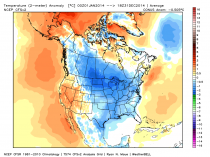
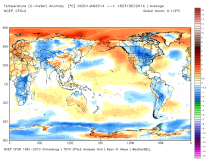
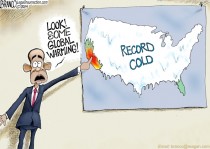
_thumb.png)
